
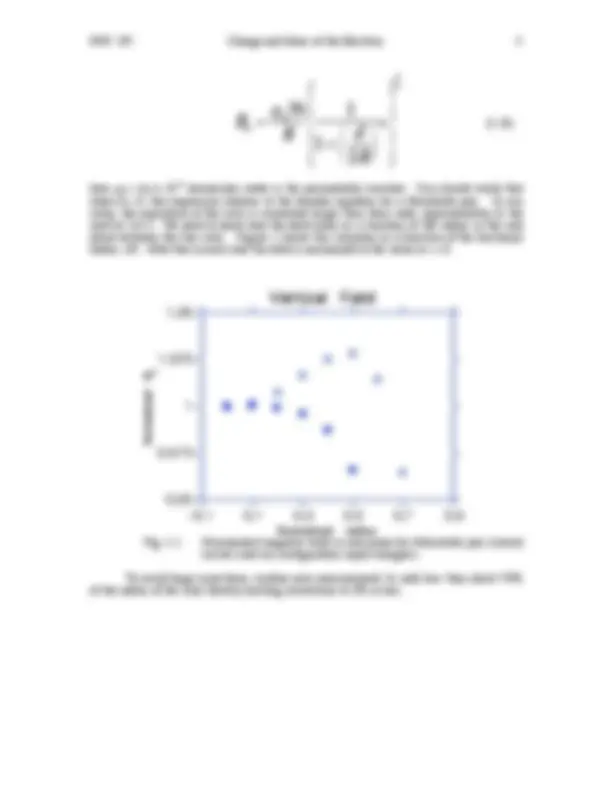
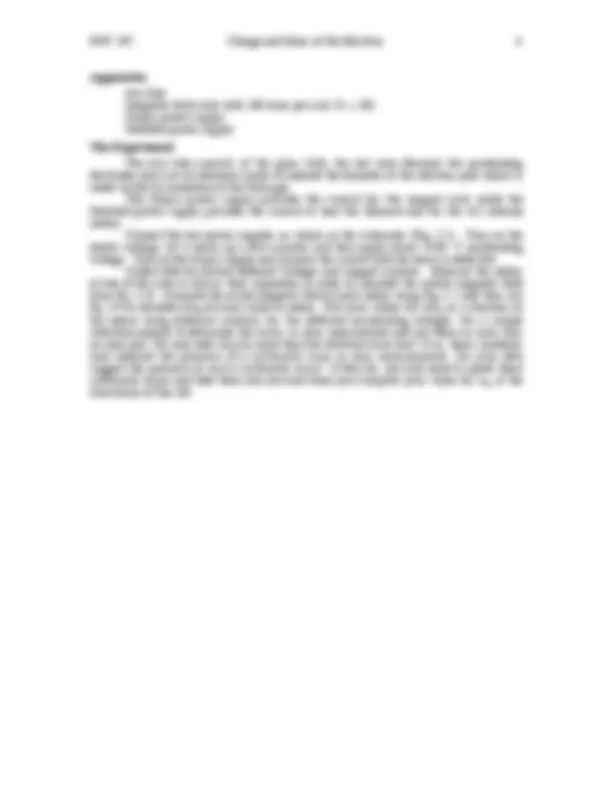
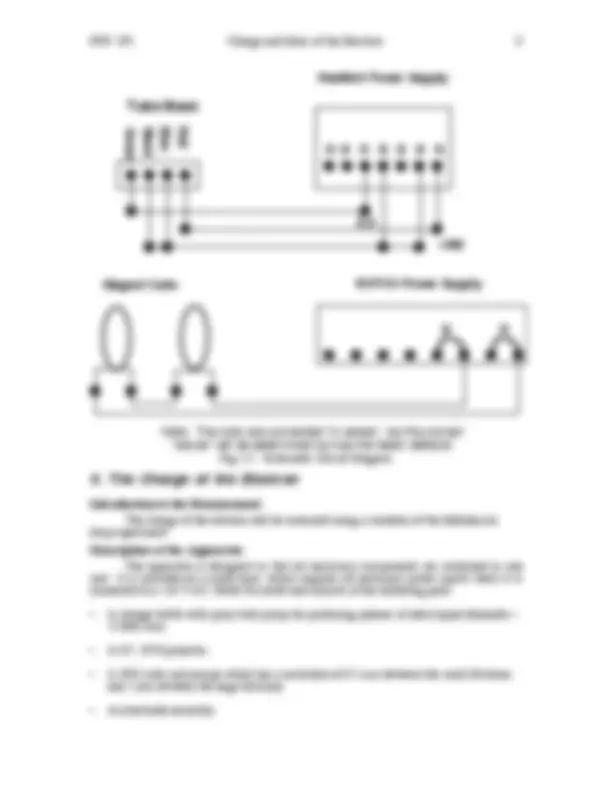
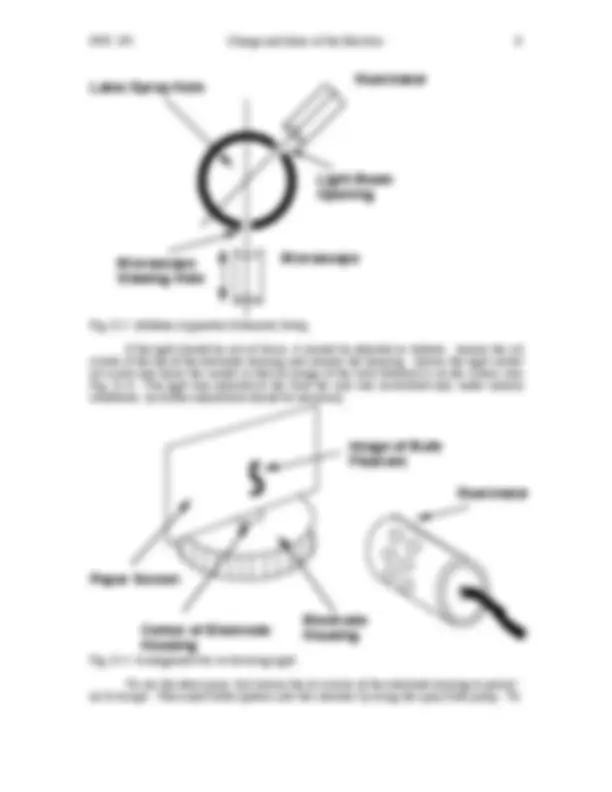
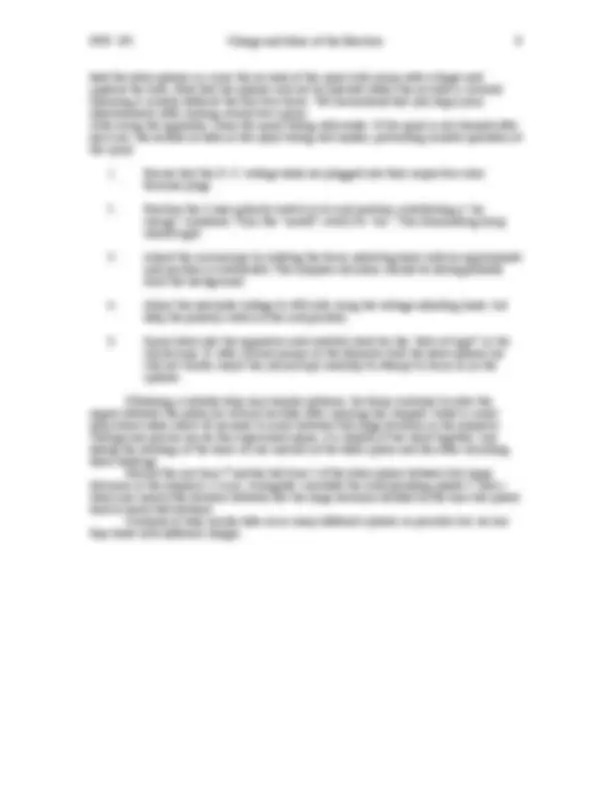
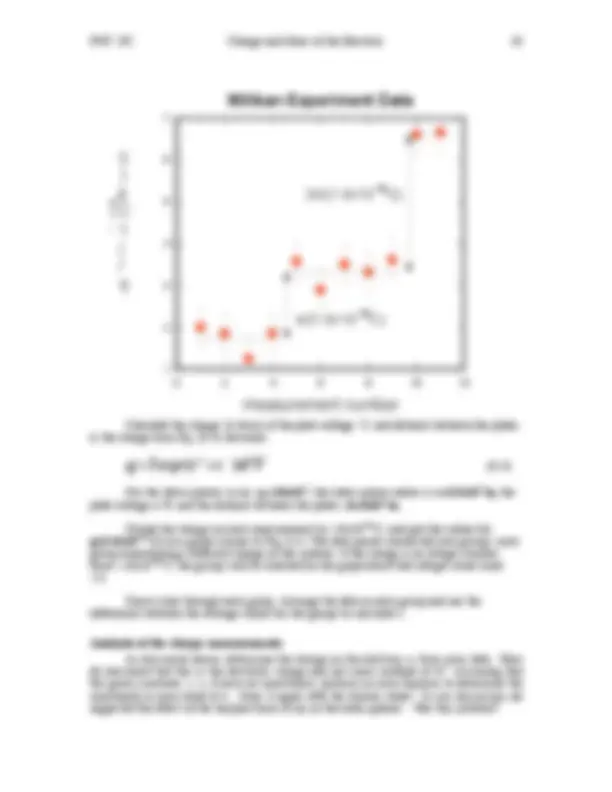


Study with the several resources on Docsity

Earn points by helping other students or get them with a premium plan


Prepare for your exams
Study with the several resources on Docsity

Earn points to download
Earn points by helping other students or get them with a premium plan
Community
Ask the community for help and clear up your study doubts
Discover the best universities in your country according to Docsity users
Free resources
Download our free guides on studying techniques, anxiety management strategies, and thesis advice from Docsity tutors
The data points should fall into groups, each group representing a different charge on the spheres. If the charge is an integer number times 1.6x10-19 C, the ...
Typology: Exams
1 / 11

This page cannot be seen from the preview
Don't miss anything!







The aim of this experiment is to measure the charge and mass of the electron. The charge will be measured directly using a variant of the Millikan oil drop experiment while the mass will be deduced from a measurement of the charge to mass ratio, e/m, combined with the charge measurement. The two separate measurements can be done in either order with the combined analysis performed at the end. Table I gives the values for the mass and charge of the electron for comparison purposes. They are known to much higher accuracy than we can hope to measure in our experiments and, therefore, they will be considered to be exact.
Electron Charge and Mass Quantity Symbol Value Units Mass me (^) 9.109 x 10-31 kg Charge e (^) 1.602 x 10-19 C
Introduction In 1897 J. J. Thompson discovered the first "elementary particle", the electron, by measuring the ratio of its charge to mass in a manner similar to the experiment that we will perform. Given the mass and charge in Table I we expect to measure a value that is close to:
−1 9
−3 1
Theory Both conceptually and experimentally this part of the experiment is quite simple. A hollow glass sphere is evacuated to a high vacuum and filled with a small amount of Neon gas at a pressure of about 1 millitor. Inside the sphere, a heated wire (a "filament") emits a large number of electrons which are accelerated by a potential difference V, to acquire kinetic energy:
2
and, therefore, a velocity:
1 2 (I-3) The moving electrons strike and ionize the Ne atoms which give off light when they recombine, producing a visible beam along the electron track. The sphere is placed in a
region where a magnetic field, B , is produced by a current in two coils of wire. B is applied perpendicular to the velocity vector of the electrons resulting in a magnetic force:
The force is perpendicular to both the velocity and the magnetic field vectors and produces an acceleration a , whose magnitude is given by:
2
where r is the radius of the circular path of the electron. (Recall that such a force is called a centripetal force and the corresponding acceleration a centripetal acceleration with both vectors directed toward the center of the circle.) Therefore:
2
which yields:
Substituting for v from Eq. 3, we obtain:
1 2 (I-8) which simplifies to:
This equation is correct IF V and B are both constant in space and time so that all the electrons have the same velocity v, and follow the same circular path of radius r. V is applied between two conducting equipotential surfaces by a stable power supply and is therefore well defined. Two coils of radius R, separated by a distance d, each having N turns with current i passing through them in the same sense, generate a magnetic field on their common axis, half way between them, equal to:
Apparatus e/m tube Magnetic field coils with 150 turns per coil: N = 150. Kepco power supply Heathkit power supply The Experiment The e/m tube consists of the glass bulb, the hot wire filament, the accelerating electrodes and a set of reference marks to indicate the diameter of the electron path which is made visible by ionization of the Neon gas. The Kepco power supply provides the current for the magnet coils while the Heathkit power supply provides the current to heat the filament and for the AC internal meters. Connect the two power supplies as shown in the schematic (Fig. I-2). Turn on the heater voltage, let it warm up a few minutes and then apply about +200 V accelerating voltage. Turn on the Kepco supply and increase the current until the beam is deflected. Collect data for several different voltages and magnet currents. Measure the radius of one of the coils as well as their separation in order to calculate the central magnetic field from Eq. I-10. Compute the actual magnetic field at each radius using Fig. I-1 and then use Eq. I-9 to calculate e/me for each value of radius. Plot your values for e/me as a function of the radius using different symbols for the different accelerating voltages. Do a simple statistical analysis to determine the errors in your measurement and put these as error bars on your plot. Do your data vary by more than the statistical error bars. If so, these variations may indicate the presence of a systematic error in your measurements. Do your data suggest the presence of such a systematic error? If they do, you will need to quote these systematic errors and take them into account when you compute your value for me at the conclusion of this lab.
Green Black Blue Red
Heathkit Power Supply +
Magnet Coils KEPCO Power Supply B R Note: The coils are connected "in series", but the correct "sense" will be determined by how the beam deflects Fig. I-2: Schematic Circuit Diagram
Introduction to the Measurement The charge of the electron will be measured using a variation of the Millikan oil drop experiment. Description of the Apparatus The apparatus is designed so that all necessary components are contained in one unit. It is mounted on a metal base, which supplies all necessary power inputs when it is connected to a 110 V AC, 50/60 Hz outlet and consists of the following parts:
Now suppose that the metal plates are connected to a source of constant potential difference such that an electric field of intensity E is established between the plates and a latex sphere of charge q is made to move upwards. The direction of the electric field must depend on the sign of the charge q, which may be either positive or negative. The resultant upward force on the charge is E q - m g and this force causes the sphere to move upwards with a terminal speed s+. The equation of motion is:
(11-2) If now the polarity of the electric field is reversed, the sphere will move downward under the combined force of gravity and the electrostatic force. The equation of motion is:
(11-3) Note that the forces are now additive and that the terminal speed is achieved in the opposite direction than in the previous case. The effect of gravity can now be eliminated by adding the equations of motion yielding:
If the terminal speeds are changed to velocities by incorporating the proper sign convention of upwards (+) and downwards (-), then one must change the symbols from s to v and add a minus (-) before the term for the downward velocity. We will not need to write that equation here because Eq. (11-4) will be sufficient for our purposes. (The corresponding equation with velocities can also lead to mistakes if one forgets that the downward velocity should have a negative sign.) Performing the Measurement Begin by setting the apparatus on a level surface. Make sure all power to the unit is turned off whenever you are making any adjustments to it. Make sure the electrode housing is set as in Figure II-2. This requires unscrewing the electrode housing set screws and removing the upper electrode housing plate. Next insert the atomizer ring between the upper and lower electrode housings and re-tighten the set screws.
Latex
Fig. II-2: Millikan Apparatus Schematic Setup If the light should be out of focus, it should be adjusted as follows: loosen the set screws at the top of the electrode housing and remove the housing: loosen the light socket set screw and move the socket so that an image of the bulb filament is on the screen (see Fig. II-3). The light was adjusted at the time the unit was assembled and, under normal conditions, no further adjustment should be necessary.
Fig. II-3: Arrangement for re-focusing light. To use the latex spray, first loosen the set screws of the electrode housing to permit air to escape. Then inject latex spheres into the chamber by using the spray bulb pump. To
1 2 3 4 5 6 7 0 2 4 6 8 10 12 Milikan Experiment Data q / ( 1 . x 1 0
1 9 C ) measurement number
Calculate the charge. In terms of the plate voltage, V, and distance between the plates, d, the charge from Eq. (II-4) becomes:
+
-
For the latex spheres in air, η =1.8x10-5, the latex sphere radius is r=5.5x10-7m, the plate voltage is V , and the distance between the plates, d=5x10-3m. Divide the charge on each measurement by 1.0x10-19^ C, and plot the values for q/(1.0x10-19^ C) on a graph similar to Fig. II-4. The data points should fall into groups, each group representing a different charge on the spheres. If the charge is an integer number times 1.6x10-19^ C, the groups will be bunched on the graph about that integer value times 1.6. Draw a line through each group. Average the data in each group and use the differences between the average values for the groups to calculate e. Analysis of the charge measurements As discussed above, determine the charge on the electron, e, from your data. How do you know that this is the electron's charge and not some multiple of it? Assuming that the given constants, r, η, d have no uncertainty, perform an error analysis to determine the uncertainty in your value of e. Does it agree with the known value? In our discussion we neglected the effect of the buoyant force of air on the latex spheres. Was this justified?
The Cleanup When the experiment is completed, clean the electrode housing. Turn it off and unplug the unit. Remove the electrode DC power cord from the terminal. Remove the pipe from the latex container. Loosen the setscrew of the electrode housing and remove the housing. Disassemble into electrode boards above and below rings. Wipe off any water and latex with a soft cloth. Clean the latex spray tube and put it back in place. Reassemble the housing and set it in the designated position (when assembling the intermediate ring, carefully align the objective lens of the microscope with the peep window).
Using the best estimate for e/m from part I of the experiment and your best estimate of e from part II, compute the mass of the electron, me, and the uncertainty in the mass, δme. Indicate whether or not your measurement agrees with the known value.
Include a brief statement of the purpose of the experiment, a description of the procedure and a summary of the raw data. Give examples of all calculations and intermediate results, using tables and graphs where appropriate. Give a summary of your final results for the charge and mass of the electron including an error analysis. Compare with the given values and discuss discrepancies, if any.